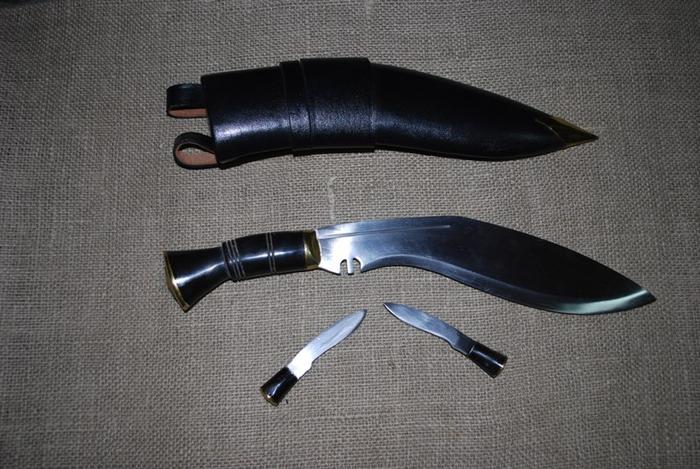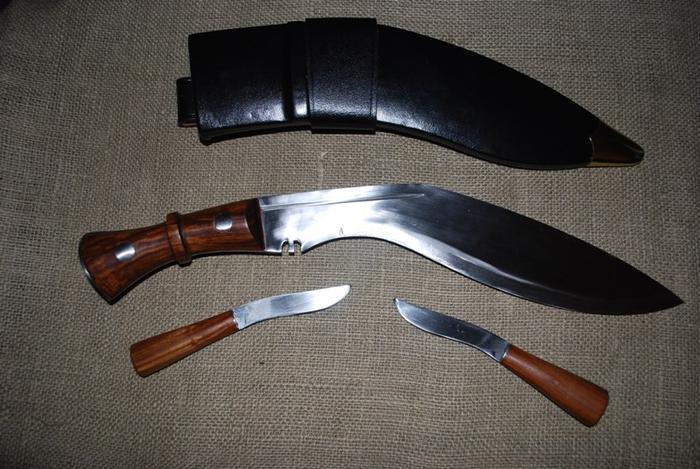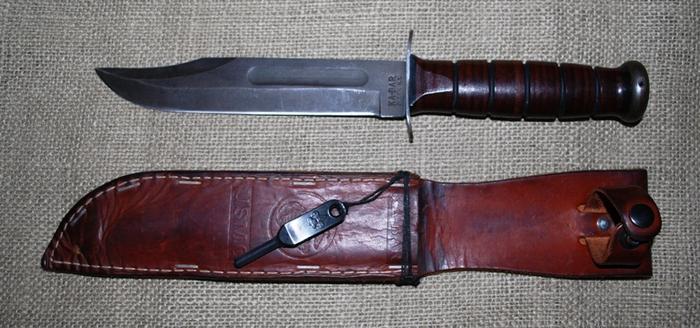Results 11 to 20 of 44
Thread: Two knives
Hybrid View
-
12-13-2012, 05:07 AM #1May your bone always be well buried




- Join Date
- Jun 2010
- Location
- Brisbane/Redcliffe, Australia
- Posts
- 6,380
Thanked: 983
Just keep in mind that not all Khukuri were 'issued'. If the Gurkha carried his own personal Khukuri, then it won't have the MOD stamp on it. There were plenty of issued and unissued Khukuri in use in the earlier wars. Not so much these days though. So stamp or no stamp, it won't detract from the family history as it applies to your blade. You should try to get as much information about that gear as you can now, before it is lost altogether.
Mick
-
12-13-2012, 05:33 AM #2

My two Khukuri's & my Ka Bar



-
12-13-2012, 02:23 AM #3"My words are of iron..."


- Join Date
- Oct 2006
- Posts
- 1,898
Thanked: 995
Wullie beat me to it.
If the second knife you refer to is the bottom one, that's got all the form of a classic Ka-Bar. Common issue for US Navy and other military personnel. This is not to say it could not be hand made, its a very good copy of a factory production knife meaning why go to the bother when you could buy one.
-
12-19-2012, 07:12 PM #4

The Kukri is the knife of the GURKAS and is a traditional fighting knife from Nepal. The odd notch in the blade is for allowing blood to drip off without getting onto the handle.
The GURKAS I've worked with/met told me the smaller knives were for skinning and general use.
Hope this helps, oh and when you draw a Kukri you have to draw blood before you put it away :-D
-
12-19-2012, 09:49 PM #5May your bone always be well buried




- Join Date
- Jun 2010
- Location
- Brisbane/Redcliffe, Australia
- Posts
- 6,380
Thanked: 983
Yes I have, just once, and I would again. My delivery came through just fine. As for use as a machete, yes you could use one as a machete, but I would tend to look into Willies idea, as a khukuri does feel odd in that useage. It would be much better as a machete than a tradtional Khukuri.
They are both, a practical means of stopping liquids running down the blade onto the handle, and subsequently your hand, making for a slippery grip. And a religious symbol.
Actually they were more of a sword to begin with. As a knife they were just tradtional, not really a tradtional fighting knife, but most certainly used for that purpose, as well as field, farm and household duties.
As for the having to draw blood, that is a misconception.
Mick
-
12-20-2012, 02:47 AM #6Junior Member

- Join Date
- Dec 2012
- Location
- Indiana
- Posts
- 24
Thanked: 0
You do have a kukri, it is used by Gurkha from Nepal. The two small knives ..... one is for striking flint the other is a small utility knife. The knife was/is used in much the same way as a machete and of course as a weapon of war by the Gurkis, fierce mercenarys used by the British. They have a stellar reputation in battle, you may want to read up on them. The other knife looks like a WW2 US Marine trench knife.
-
12-20-2012, 06:16 AM #7
-
12-20-2012, 10:55 AM #8
-
12-20-2012, 11:00 AM #9
-
12-20-2012, 11:26 AM #10May your bone always be well buried




- Join Date
- Jun 2010
- Location
- Brisbane/Redcliffe, Australia
- Posts
- 6,380
Thanked: 983
They did that well enough against the Japanese in WWII (amongst other times, people and places), but the Japanese at that time were considered almost invinceable. I can't recall all the information of the particular battle I was told about, but the Gurkha's were all but wiped out. One badly wounded Gurkha was all that was left to fight and he was out of ammunition, his mates lying around either dead or wounded so badly they couldn't fight. He drew his Khukuri and prepared for his last ditch effort, dispatching several Japanese in those final hours before the Japs retreated in defeat, thoroughly de-moralised by the Gurkha's shouting out challenges to come and get him if they could... Reinforcements arrived and he and a few of his mates survived. One of many stories I was once told anyway.
Mick


 36Likes
36Likes LinkBack URL
LinkBack URL About LinkBacks
About LinkBacks






 Reply With Quote
Reply With Quote


